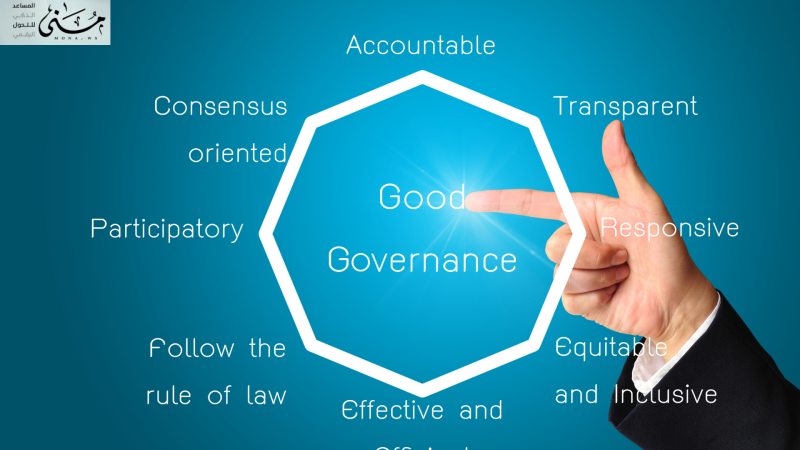Corporate governance is no longer an administrative luxury or a deferred organizational option. Rather, it has become a pillar of organizational success in facing market challenges, ensuring operational sustainability, regulatory compliance, and achieving transparency. However, many organizations overlook the true starting point for achieving corporate governance.
Continue reading the article to learn more about corporate governance.
What is corporate governance?
Corporate governance is a set of rules, controls, and procedures that define how an organization is managed and directed, ensuring transparency, accountability, and fairness in decision-making. Governance aims to protect the interests of all stakeholders, including shareholders, employees, customers, and the community.
One of the most important elements of corporate governance
TransparencyProviding accurate and reliable information about the organization's performance and operations.
Accountability: Determine responsibilities and accountability for decisions and actions.
justice:Ensuring that all stakeholders are treated fairly and equitably.
CensorshipThe existence of effective control mechanisms to ensure compliance with rules and regulations.
Administrative structure and corporate governance
In a rapidly changing world where compliance and transparency requirements are accelerating, corporate governance can no longer be achieved without starting with a flexible and integrated management structure. The management structure is not just a chart that defines who manages whom, but rather the backbone upon which decisions, oversight, and the distribution of tasks are based.
Through it, responsibilities are clarified, authorities are determined, and trust is built in the decisions made within the organization. When powers are precisely defined and administrative relationships are clear, the organization takes its first steps toward sustainable corporate governance.
Governance begins with defining who has the right to make decisions, who has the authority to implement them, and who bears the responsibility for verification and review. These three dimensions—decision-making, implementation, and oversight—can only coexist healthily within a precise organizational structure that respects administrative hierarchy and prevents duplication or conflict of roles. This is the essence of corporate governance, which is not merely a matter of top-down policy but rather practical practices reflected in every administrative detail.
What distinguishes a successful administrative structure is that it is able to support communication between different levels, facilitate the flow of information, and link strategic objectives to daily implementation. The more precise the organization’s structure is, the greater the chances of achieving effective governance. From this standpoint, modern technical tools such as:DocSuite Structure enables planning and digitizing the administrative structure in a way that ensures its continuous updating and linking it to the general administrative system, thus enhancing corporate governance practices in daily life.
Distribution of powers and responsibilities
One of the most significant challenges hindering the implementation of governance is the lack of a clear and balanced distribution of powers and responsibilities. Many organizations may suffer from a concentration of power in the hands of a single individual, unclear tasks between departments, or duplication of roles between divisions. These administrative problems may not be immediately apparent, but they gradually lead to disrupted productivity, eroded trust, and conflicts of interest, all at the expense of the integrity of corporate governance.
To overcome this, a comprehensive matrix must be developed that links each job position to its precise powers: What does it decide? What does it approve? What does it review? When does it intervene? These questions are not merely formal; they are the core of corporate governance. Every organization relies on multiple, overlapping, and complementary roles. If these roles are not clearly regulated, administrative chaos will inevitably result.
Here comes the importance of documenting administrative powers and linking them to smart systems such as:DocSuite Structure, where digital permissions can be assigned to each employee based on their position within the administrative structure. These permissions can also be periodically reviewed to ensure they are consistent with business developments, allowing for the implementation of corporate governance in its interactive, rather than static, sense.
Governance is not limited to establishing a structure and distributing powers. Rather, it requires monitoring the implementation of these powers in practice. An official who is not held accountable, or who does not follow a clear administrative chain of command, is a weak point in the chain of corporate governance, no matter how ideal the plans may seem.
Digitization as a means of achieving corporate governance
With the increasing expansion of digital transformation systems, governance has become more closely linked to technological tools that enable management, oversight, and accountability in an integrated digital environment. Reliance on filesExcel or paper documents are no longer acceptable in today's business environments that require instant interaction and constant transparency.
Specialized digital tools such as:DocSuite Structure enables government agencies and private companies to build a flexible administrative structure that intelligently links powers and responsibilities. Through an interactive interface, the structure can be redesigned, administrative titles modified, or tasks transferred from one department to another, while maintaining the administrative hierarchy and linking to approved policy documents. This supports the accurate and realistic implementation of corporate governance.
Likewise, linking the administrative structure with internal automation systems (such as task management, meetings, documents, and correspondence) creates an integrated environment that leads to improved decision-making, the allocation of responsibilities, and the application of accountability—all pillars of contemporary governance. Digitization is not an end in itself, but rather a means to establish an administrative culture based on transparency, compliance, and accountability.
It is important to note that organizations that implement digital governance are better prepared for audit and legal compliance requirements, as data, documents, and decisions are stored and archived in a manner that facilitates access and analysis, whether for internal audit purposes or by external regulatory bodies.
From governance of form to governance of behavior
The administrative structure represents the physical image of governance, but this structure cannot achieve its objectives unless it is supported by a corporate culture that believes in good governance, compliance, and discipline. Governance is not just a matter of organization or a chart; it is a daily behavior and ethical decision that must begin with senior management and extend to all employees.
Often, corporate governance fails because leaders don't actually commit to it, or because it is treated as a formal duty without real adoption. This is where governance becomes essential: transforming it from a mere organizational concept into a comprehensive culture that influences decisions, is reflected in internal discourse, and translates into practices such as rejecting conflicts of interest, combating favoritism, adhering to periodic reports, and respecting the administrative hierarchy.
This is why it is important to link the administrative structure to evaluation and accountability plans, and for each administrative position to be linked to performance indicators that are periodically reviewed and linked to incentives or corrective actions. This is the heart of governance: for every individual to feel that they are part of a clear system that does not allow for exceptions or circumvention of procedures.
Here it is necessary to note once again the role played by digital tools such as:DocSuite Structure not only builds the structure, but also documents it and links it to reporting, evaluation, and continuous updates, transforming governance from a theoretical blueprint into a living system that evolves with the organization and serves its strategic goals.
How does your organization begin its corporate governance journey through the management structure?
For those who wish to build an administrative structure that serves the implementation of corporate governance in a practical and effective manner, here are the following steps:
Analysis of the current situation: Listing the current departments and positions and defining the actual powers and responsibilities.
Drawing the initial organizational structureTaking into account administrative hierarchy, clarity of powers, and linkage between units.
Identify gaps:such as overlapping roles, lack of accountability, centralization of power, or poor coordination.
redistribution of powersSo that responsibility is commensurate with authority and administrative justice is achieved.
Digitizing the structureUsing tools like:DocSuite Structure that facilitates documentation, tracking, and modification.
Linking the structure to the work systems: Such as managing tasks, documents, meetings, and corporate email.
Disseminating corporate cultureBy training employees and emphasizing the importance of adhering to the approved structure and powers.
Continuous assessmentThrough performance indicators of the structure itself and the extent to which it serves the principles of corporate governance.
Corporate governance is not just documents filed away in drawers, nor is it an annual report sent to regulatory bodies. Rather, it is a practice that begins with defining who owns decisions, how they are made, and how they are reviewed. The administrative structure is the most important means of translating these principles into a living system. Therefore, every organization that aspires to sustainability, transparency, and efficiency must begin where authority is established and responsibility is divided: with the structure.
 ما هي الحوكمة المؤسسية؟ كيف تصنع فرقًا حقيقيًا؟
ما هي الحوكمة المؤسسية؟ كيف تصنع فرقًا حقيقيًا؟










Comments
Add New Comment